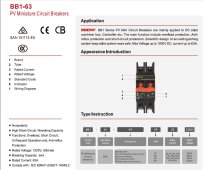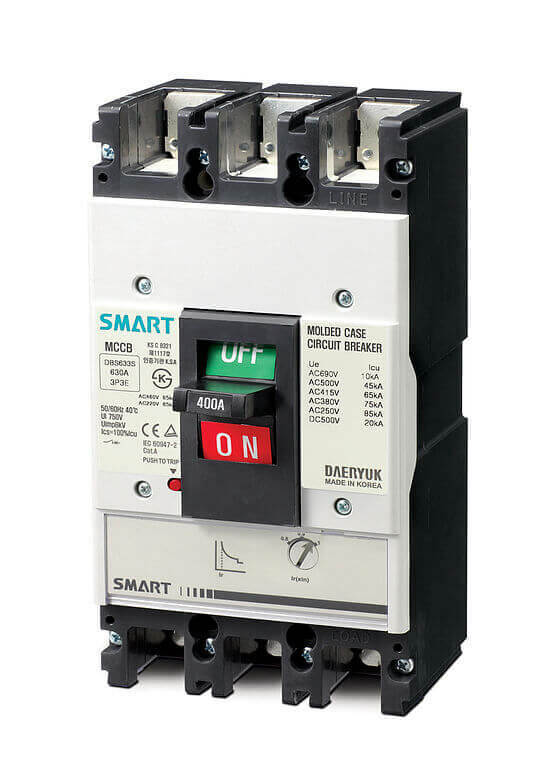Australians, everything's upside down.The guy in the video was saying they were often wired up back to front.
You are using an out of date browser. It may not display this or other websites correctly.
You should upgrade or use an alternative browser.
You should upgrade or use an alternative browser.
Safely using MCB (mini circuit breakers) for PV & Bi-Directional Battery Protection
- Thread starter LifeWAT
- Start date
Hedges
I See Electromagnetic Fields!
- Joined
- Mar 28, 2020
- Messages
- 21,094
So these are polarized, and single directional, and are good for solar panels? Just so we can put that to bed.
If wired up correctly they should be fine for solar panels, as the current always flows in the same direction with panels. The guy in the video was saying they were often wired up back to front.
If they are polarized, they can be used as a single disconnect because current only flows from PV positive, through breaker to SCC, back from SCC to PV negative.
(An EE type might say "current flows from negative to positive" but I'll ignore that. Could be more accurate to say electrons flow from negative to positive, and holes flow from positive to negative, but let's ignore facts and semantics.)
If you have three or more PV strings in parallel, do not use a polarize breaker to protect each string. That is because current flows one way in normal operation, but in reverse direction of a PV string is shorted and the other two strings dump current into it.
In that case, fuses or non-polarized breakers should be used. Or, I think, if all poles of all breakers are ganged it will be OK because when one trips it turns off the others which are conducting in forward direction.
Ron-ski
Solar Enthusiast
In that case, fuses or non-polarized breakers should be used. Or, I think, if all poles of all breakers are ganged it will be OK because when one trips it turns off the others which are conducting in forward direction.
I've got rotatory isolators on each string, then a fuse, then the two strings are combined in to parallel, then a non polarised MCB between the combiner and the MPPT. So hopefully I have everything there covered, belts and braces.
william zhu
New Member
- Joined
- Dec 8, 2022
- Messages
- 1
I am william and from Projoy company, and i am responsible for Projoy Alibaba's online order businessMOQ is 200 pcs
I dont know of anyone is looking at this as its an old thread. Do u think those small numbers mean something the 1-2, 3-4 I see that in some mcb it is as 1-3, 2-4 I assume the latter is bidirectional. But if someone with more knowledge could tell.
Ron-ski
Solar Enthusiast
@Pulith You need to look at the little diagram on the MCB and decipher that.
Attachments
Ron-ski
Solar Enthusiast
I'm not sure on the relevance of the numbers, probably just terminal numbering, but that is not bi-directional going by the diagram.
Do u have an image for bidirectional would be very helpful.I'm not sure on the relevance of the numbers, probably just terminal numbering, but that is not bi-directional going by the diagram.
Ron-ski
Solar Enthusiast
That's not a breaker, it's an isolator.
Ron-ski
Solar Enthusiast
You sure about that???? Why do you think that?That's not a breaker, it's an isolator.
The manufacturer specifically refers to it as an MCB - see the picture below, and specifications attached. It even has a trip curve in the specs. I also use Z Beny's larger moulded case breakers for my batteries.
In my use case its used as an isolator for a fused combiner box, each positive and negative of each string is individually fused. My batteries also have T class fuses, and a breaker. I also have these MCB's between the busbar and MPPT's.
Z Beny is one of the few manufactures that appear to specifically mention no polarity and that they are for PV, hence there is no + or - marked on the diagram.

Attachments
Ron-ski
Solar Enthusiast
@BiduleOhm To be honest apart from the switch part of the diagram I've got no idea what the other symbols mean, I just ordered what I considered was appropriate parts going by the manufacturers description, well the second time round anyway.
Sleeper85
Sunday handyman
- Joined
- Nov 28, 2022
- Messages
- 446
Personally, the question I ask myself is at how many amps the thermal protection will come into operation.
Regarding the MCCB TOMZN I don't even know its trip curve.
Is it B, C or D?
No technical information which is a shame.
Even in the case of curve B we can imagine that a MCCB of 100A will not trigger before perhaps 300A.
Below is an interesting article on the subject.

 www.gses.com.au
www.gses.com.au
Edit : TOMZN's answer, "should be" a C curve ?
That said, this does not matter in my opinion, the cables must be sized to support the maximum power of the solar charge controller and the inverter, it could never be greater. The usefulness of this breaker will therefore be to be able to isolate part of the system (I use it for my battery) and above all to interrupt a short circuit which the magnetic part will do instantly. On the other hand, for the thermal part, you will probably never see it trigger in the event of over-current.
Regarding the MCCB TOMZN I don't even know its trip curve.
Is it B, C or D?
No technical information which is a shame.
Even in the case of curve B we can imagine that a MCCB of 100A will not trigger before perhaps 300A.
Below is an interesting article on the subject.

Moulded Case Circuit Breakers Explained - GSES
As installed system capacity continues to increase in the Australian PV market, it is valuable for system designers and installers to understand the mechanisms behind moulded case circuit breakers, and the meaning behind their ratings. A moulded case circuit breaker (MCCB) is a type of...
Edit : TOMZN's answer, "should be" a C curve ?
That said, this does not matter in my opinion, the cables must be sized to support the maximum power of the solar charge controller and the inverter, it could never be greater. The usefulness of this breaker will therefore be to be able to isolate part of the system (I use it for my battery) and above all to interrupt a short circuit which the magnetic part will do instantly. On the other hand, for the thermal part, you will probably never see it trigger in the event of over-current.
Last edited:
Similar threads
- Replies
- 4
- Views
- 268
- Replies
- 17
- Views
- 1K
- Replies
- 4
- Views
- 624
- Replies
- 58
- Views
- 5K
- Replies
- 1
- Views
- 260





